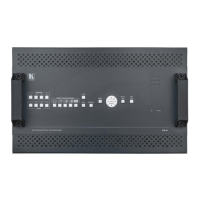Set analog output
settings.
COMMAND
#MUTE-ANAchannel,mute_mode<CR>
FEEDBACK
~nn@MUTE-ANAchannel,mute_mode<CR><LF>
channel – * (All)
mute_mode – 0 – off unmute, 1 – on
mute
Set analog output
settings:
#MUTE-ANA*,1<CR>
Get analog output
settings.
COMMAND
#MUTE-ANA?channel<CR>
FEEDBACK
~nn@MUTE-ANAchannel,mute_mode<CR><LF>
channel – * (All)
mute_mode – 0 – off unmute, 1 – on
mute
Get analog output
settings:
#MUTE<CR>
Set DHCP mode.
Only 1 is relevant for
the mode value. To
disable DHCP, the user
must configure a static IP
address for the device.
Connecting Ethernet to
devices with DHCP may
take more time in some
networks.
To connect with a
randomly assigned IP by
DHCP, specify the device
DNS name (if available)
using the NAME command.
You can also get an
assigned IP by direct
connection to USB or RS-
232 protocol port, if
available.
For proper settings
consult your network
administrator.
For Backward
compatibility, the id
parameter can be omitted.
In this case, the Network
ID, by default, is 0, which
is the Ethernet control
port.
COMMAND
#NET-DHCPnetw_id,dhcp_state<CR>
FEEDBACK
~nn@NET-DHCPnetw_id,dhcp_state<CR><LF>
netw_id – Network ID–the device
network interface (if there are more than
one). Counting is 0 based, meaning the
control port is ‘0’, additional ports are
1,2,3….
dhcp_state –
1 – Try to use DHCP. (If unavailable,
use the IP address set by the
factory or the net-ip command).
Enable DHCP mode for
port 1, if available:
#NET-DHCP1,1<CR>
Get DHCP mode.
For Backward
compatibility, the id
parameter can be omitted.
In this case, the Network
ID, by default, is 0, which
is the Ethernet control
port.
COMMAND
#NET-DHCP?netw_id<CR>
FEEDBACK
~nn@NET-DHCPnetw_id,dhcp_mode<CR><LF>
netw_id – Network ID–the device
network interface (if there are more than
one). Counting is 0 based, meaning the
control port is ‘0’, additional ports are
1,2,3….
dhcp_mode –
0 – Do not use DHCP. Use the IP set
by the factory or using the net-ip
or net-config command.
1 – Try to use DHCP. If unavailable,
use the IP set by the factory or
using the net-ip or net-config
command.
Get DHCP mode for port
1:
#NET-DHCP?1<CR>
Set gateway IP.
A network gateway
connects the device via
another network and
maybe over the Internet.
Be careful of security
issues. For proper
settings consult your
network administrator.
COMMAND
#NET-GATEip_address<CR>
FEEDBACK
~nn@NET-GATEip_address<CR><LF>
ip_address – Format: xxx.xxx.xxx.xxx
Set the gateway IP
address to 192.168.0.1:
#NET-
GATE192.168.000.0
01<CR>
Get gateway IP.
A network gateway
connects the device via
another network and
maybe over the Internet.
Be aware of security
problems.
COMMAND
#NET-GATE?<CR>
FEEDBACK
~nn@NET-GATEip_address<CR><LF>
ip_address – Format: xxx.xxx.xxx.xxx
Get the gateway IP
address:
#NET-GATE?<CR>
Set IP address.
For proper settings
consult your network
administrator.
COMMAND
#NET-IPip_address<CR>
FEEDBACK
~nn@NET-IPip_address<CR><LF>
ip_address – Format: xxx.xxx.xxx.xxx
Set the IP address to
192.168.1.39:
#NET-
IP192.168.001.039
<CR>
COMMAND
#NET-IP?<CR>
FEEDBACK
~nn@NET-IPip_address<CR><LF>
ip_address – Format: xxx.xxx.xxx.xxx
Get the IP address:
#NET-IP?<CR>
Get MAC address.
For backward
compatibility, the id
parameter can be omitted.
In this case, the Network
ID, by default, is 0, which
is the Ethernet control
port.
COMMAND
#NET-MAC?id<CR>
FEEDBACK
~nn@NET-MACid,mac_address<CR><LF>
id – Network ID–the device network
interface (if there are more than one).
Counting is 0 based, meaning the
control port is ‘0’, additional ports are
1,2,3….
mac_address – Unique MAC address.
Format: XX-XX-XX-XX-XX-XX where X
is hex digit

